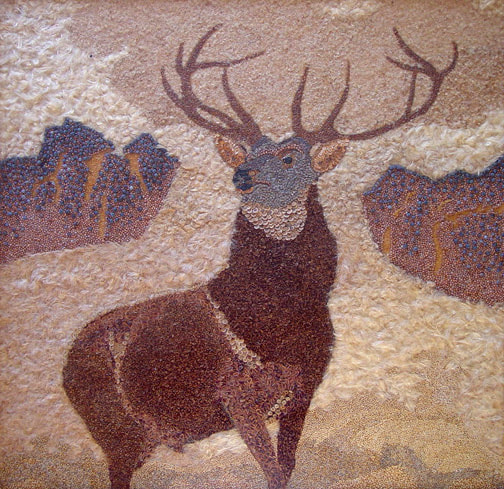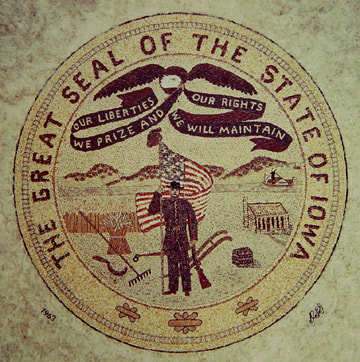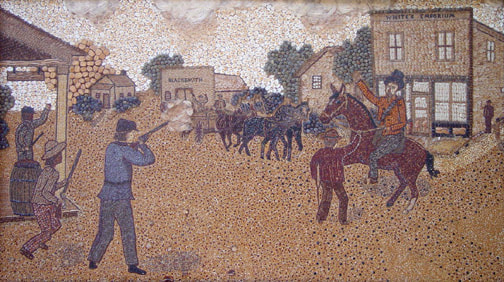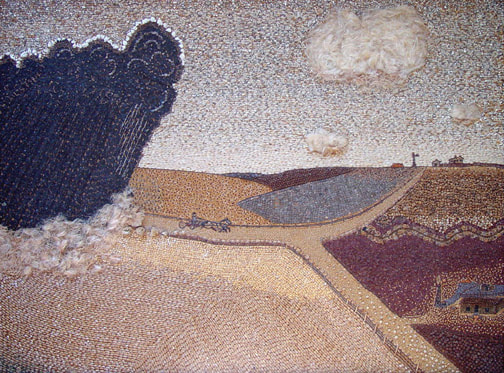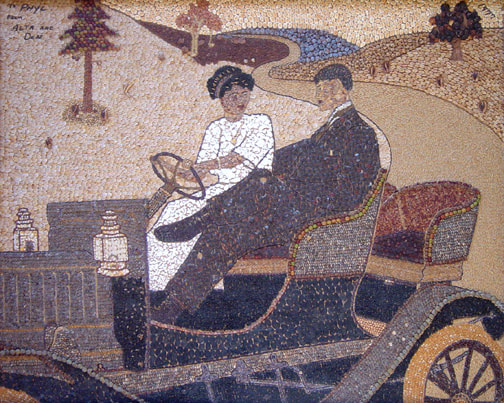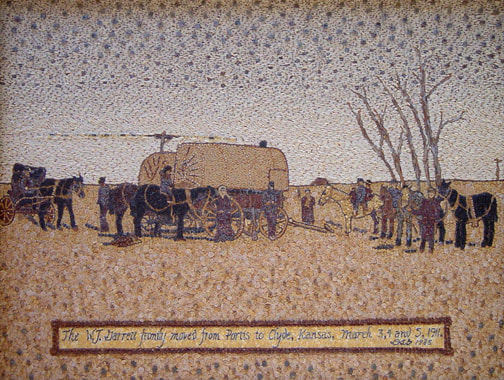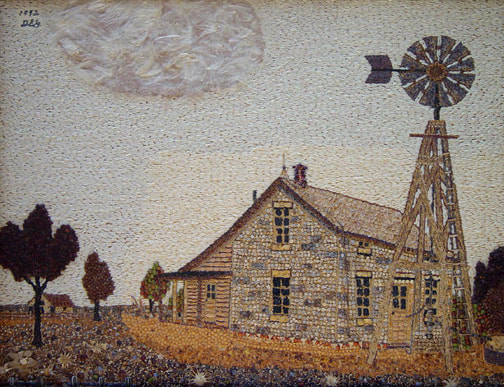|
Donald S. Garrett (1908-1999), inspired by a visit to the Corn Palace in Mitchell, South Dakota, created seed pictures out of native grass and various wildflower seeds. Using the moistened end of a flat toothpick, he placed each individual seed on the picture. Depending on which side of the seed he used, he achieved different textures and colors. It took approximately one hour to complete one square inch. The largest of the seed pictures is almost two feet by two feet in size. He created a total of seven pictures. |
|
Monarch of the Glen, completed in 1961, was Garrett's first seed picture. The dimensions of the picture are 23.5 by 23.5. Seeds used include Ash, Asparagus, Button Weed, Carrot, Cattail, Curly Malice, Flax, Foxtail, Goldenrod, Hollyhock, Lettuce, Milkweed, Mullein, Plantain, Poppy, Potato, Radish, Red Cedar, Sailor's Button, Sesame, Sourdock, Timothy, Wild Millet, Wild Parsnip, White Clover, Yucca and a a Soloman's Seal seed for the eye.
The Great Seal of Iowa was completed in 1963 and was presented to Governor Hughes and the State of Iowa. Seeds used in the picture include Artichoke, Bibb Lettuce, Blue Grass, Brome, Butter Print, Canary Grass, Carrot, Corn, Curly Malice, Flax, Hollyhock, Horsemint, Horse Nettle, Hydrangea, Jack-in-the-Pulpit, Milkweed, Mint, Mullein, Oats, Pigweed, Poppy, Pepper Grass, Pussywillow, Ragweed, Red Clover, Ragged Sailor, Sesame, Smart Weed, Sourdock, Spinach, Tickle Grass, Tomato, Turnip, Vetch, Water Grass, White Clover, Wintercress, Yucca, and Zinnia. (The above photo is a photograph of the original picture.)
The Skunk River War depicts the "Tally War", the assassination of a Southern sympathizer during a rally in South English, Iowa, during the Civil War. The picture, measuring 23.5 by 13.5 inches, was completed in 1974. Seeds used include Pearled Barley for the sky, and Peas and Okra for the trees. The men: Radish, Poppy Seed, White Clover, Pigweed and Button Weed. Smoke from the gun: Pussy Willow and Cattail. The front of the Blacksmith shop: lettuce seeds; the shingles, parsnip seeds; and the lettering, pigweed seeds. The house on the left: the siding, Oakleaf lettuce and the roof, Dill. The jacket on the man by the horse is dyed clover seed (commercial seed, the only dyed seed used). On the man on the horse, the sash is Sumac, the jacket, Millet, and the pants, Ragweed. White's Emporium: the siding, Parsnips; lettering, Columbine; corner, Hibiscus; windows, Rice and Cucumber; and the walk, Sunflower. The white on the horse is popped popcorn; other seeds are Onion and Sourdock. The road is mostly Foxtail, the black - Smartweed and Rhubarb.
Hailstorm over Kansas depicts a story Garrett heard told by his father of a neighbor's tall tale - "that the neighbor was coming home from town when a hailstorm came up. The neighbor raced home, just managing to keep ahead of the storm. There was a dog riding in the back of the wagon and it hailed so bad that it killed the dog." Hailstorm Over Kansas was completed in 1975. The picture measures 27.5 by 21.5 inches. Seeds used include cracked Indian Corn, wheat and rice in the sky; Milkweed and Cattail for the clouds; popped Corn, Ragweed, Yucca, Buttonweed, Onion, and White Clover for the storm cloud; Cattail and Pussywill for the dust; Oak Leaf Lettuce and Spinach for the road; Hulled Oats and Wheat in the "southwest field"; Foxtail, Sourdock and Ragweed "north of the road"; Mullein for the lines of the wire fence; Buttonweed for the gray field; Hibiscus and Cedar Berries for the dark brown field; Tomato seed, Foxtail, Beet and Spinach for the right top of the road; White Clover, Sourdock, Hollyhock, Radish, Curly Malice, Spinach, and Poppy for the creek; Pigweed for the windmill and outline of the horses; Salsify and Canary Grass for the fence posts; Millet for the haystack; Poppy Seed for the overalls; Parsnip for the edge of the road; and Hibiscus and Lettuce for the cabin.
Smith's Wedding was completed in 1977 as a gift for Garrett's sister-in-law, Phyllis Miel. The picture measures 19.5 by 15.5 inches and is taken from Tracy and Gean Smith's wedding photograph. Seeds used include Pearled Barley, Parsnip, Coralberry, Cedar Berry, Beet, Wheat, Rhubarb, Salsify, Pigweed, Mung Beans, Flax Seed, Foxtail, Clover, Sesame, Onion, Canary Grass, Ivy, Mullein, Turnips, popped Popcorn, Corn, Yucca, Redbud, Rice, Dill, Smartweed, Okra, Hibiscus, Carrot, and Mustard.
Moving in Kansas was completed in 1985. The picture measures 19.5 by 15.5 inches. The picture is from an old postcard photo showing the Garrett family moving from Portis to Clyde, Kansas March 3, 4, and 5, 1911. On the telephone wire, spelled in Morse Code in Pigweed and Blacked-Seeded Lettuce, is "natural seeds." Seeds used include Cedar Berries, Pigweed, Rice, Salsify, Cosmos, Foxtail, Oak Leaf Lettuce, Flaxseed, Poppyseed, Sourdock, Sesame Seed, Rye, Wild Parsnips, Beet, Hibiscus.
The Stone House was Garrett's last seed picture and was completed in 1992. The picture measures 19.5 by 15.5 inches and depicts the stone house where he was born in 1908. Seeds used include Rice for the sky; Milkweed and Cattail for the cloud; a Poppy seed pod top for the center of the windmill; Poppy seed, Turnip, Hibiscus and Onion for the windmill wheel, Reed's Canary Grass, Oak Leaf Lettuce, and Lespedeza for the windmill structure. For the house: Red Popcorn for the chimney; Cosmos for the lightning rod; Onion for the stove pipe; Wild Parsnip for the roof shingles; Hibiscus and Partridge Pea for the eaves; Spinach and Buttonweed for the stones; Bittersweet for the lintels and sills; Yucca for the window panes; Cucumber for the built-on addition; and Sesame and Flaxseed for the porch posts. Sumac, Onion stem, Hibiscus and Mung Beans for the trees and shrubs; Milkweed for the barn roof; Onion for the water tank and Yucca for the water; Pepper and Yellow Horse Nettle for the path around the house and a mixture of wild seeds for the foreground.
Photographs of the seed pictures were taken by Evan Garrett.
The Great Seal of Iowa was completed in 1963 and was presented to Governor Hughes and the State of Iowa. Seeds used in the picture include Artichoke, Bibb Lettuce, Blue Grass, Brome, Butter Print, Canary Grass, Carrot, Corn, Curly Malice, Flax, Hollyhock, Horsemint, Horse Nettle, Hydrangea, Jack-in-the-Pulpit, Milkweed, Mint, Mullein, Oats, Pigweed, Poppy, Pepper Grass, Pussywillow, Ragweed, Red Clover, Ragged Sailor, Sesame, Smart Weed, Sourdock, Spinach, Tickle Grass, Tomato, Turnip, Vetch, Water Grass, White Clover, Wintercress, Yucca, and Zinnia. (The above photo is a photograph of the original picture.)
The Skunk River War depicts the "Tally War", the assassination of a Southern sympathizer during a rally in South English, Iowa, during the Civil War. The picture, measuring 23.5 by 13.5 inches, was completed in 1974. Seeds used include Pearled Barley for the sky, and Peas and Okra for the trees. The men: Radish, Poppy Seed, White Clover, Pigweed and Button Weed. Smoke from the gun: Pussy Willow and Cattail. The front of the Blacksmith shop: lettuce seeds; the shingles, parsnip seeds; and the lettering, pigweed seeds. The house on the left: the siding, Oakleaf lettuce and the roof, Dill. The jacket on the man by the horse is dyed clover seed (commercial seed, the only dyed seed used). On the man on the horse, the sash is Sumac, the jacket, Millet, and the pants, Ragweed. White's Emporium: the siding, Parsnips; lettering, Columbine; corner, Hibiscus; windows, Rice and Cucumber; and the walk, Sunflower. The white on the horse is popped popcorn; other seeds are Onion and Sourdock. The road is mostly Foxtail, the black - Smartweed and Rhubarb.
Hailstorm over Kansas depicts a story Garrett heard told by his father of a neighbor's tall tale - "that the neighbor was coming home from town when a hailstorm came up. The neighbor raced home, just managing to keep ahead of the storm. There was a dog riding in the back of the wagon and it hailed so bad that it killed the dog." Hailstorm Over Kansas was completed in 1975. The picture measures 27.5 by 21.5 inches. Seeds used include cracked Indian Corn, wheat and rice in the sky; Milkweed and Cattail for the clouds; popped Corn, Ragweed, Yucca, Buttonweed, Onion, and White Clover for the storm cloud; Cattail and Pussywill for the dust; Oak Leaf Lettuce and Spinach for the road; Hulled Oats and Wheat in the "southwest field"; Foxtail, Sourdock and Ragweed "north of the road"; Mullein for the lines of the wire fence; Buttonweed for the gray field; Hibiscus and Cedar Berries for the dark brown field; Tomato seed, Foxtail, Beet and Spinach for the right top of the road; White Clover, Sourdock, Hollyhock, Radish, Curly Malice, Spinach, and Poppy for the creek; Pigweed for the windmill and outline of the horses; Salsify and Canary Grass for the fence posts; Millet for the haystack; Poppy Seed for the overalls; Parsnip for the edge of the road; and Hibiscus and Lettuce for the cabin.
Smith's Wedding was completed in 1977 as a gift for Garrett's sister-in-law, Phyllis Miel. The picture measures 19.5 by 15.5 inches and is taken from Tracy and Gean Smith's wedding photograph. Seeds used include Pearled Barley, Parsnip, Coralberry, Cedar Berry, Beet, Wheat, Rhubarb, Salsify, Pigweed, Mung Beans, Flax Seed, Foxtail, Clover, Sesame, Onion, Canary Grass, Ivy, Mullein, Turnips, popped Popcorn, Corn, Yucca, Redbud, Rice, Dill, Smartweed, Okra, Hibiscus, Carrot, and Mustard.
Moving in Kansas was completed in 1985. The picture measures 19.5 by 15.5 inches. The picture is from an old postcard photo showing the Garrett family moving from Portis to Clyde, Kansas March 3, 4, and 5, 1911. On the telephone wire, spelled in Morse Code in Pigweed and Blacked-Seeded Lettuce, is "natural seeds." Seeds used include Cedar Berries, Pigweed, Rice, Salsify, Cosmos, Foxtail, Oak Leaf Lettuce, Flaxseed, Poppyseed, Sourdock, Sesame Seed, Rye, Wild Parsnips, Beet, Hibiscus.
The Stone House was Garrett's last seed picture and was completed in 1992. The picture measures 19.5 by 15.5 inches and depicts the stone house where he was born in 1908. Seeds used include Rice for the sky; Milkweed and Cattail for the cloud; a Poppy seed pod top for the center of the windmill; Poppy seed, Turnip, Hibiscus and Onion for the windmill wheel, Reed's Canary Grass, Oak Leaf Lettuce, and Lespedeza for the windmill structure. For the house: Red Popcorn for the chimney; Cosmos for the lightning rod; Onion for the stove pipe; Wild Parsnip for the roof shingles; Hibiscus and Partridge Pea for the eaves; Spinach and Buttonweed for the stones; Bittersweet for the lintels and sills; Yucca for the window panes; Cucumber for the built-on addition; and Sesame and Flaxseed for the porch posts. Sumac, Onion stem, Hibiscus and Mung Beans for the trees and shrubs; Milkweed for the barn roof; Onion for the water tank and Yucca for the water; Pepper and Yellow Horse Nettle for the path around the house and a mixture of wild seeds for the foreground.
Photographs of the seed pictures were taken by Evan Garrett.

